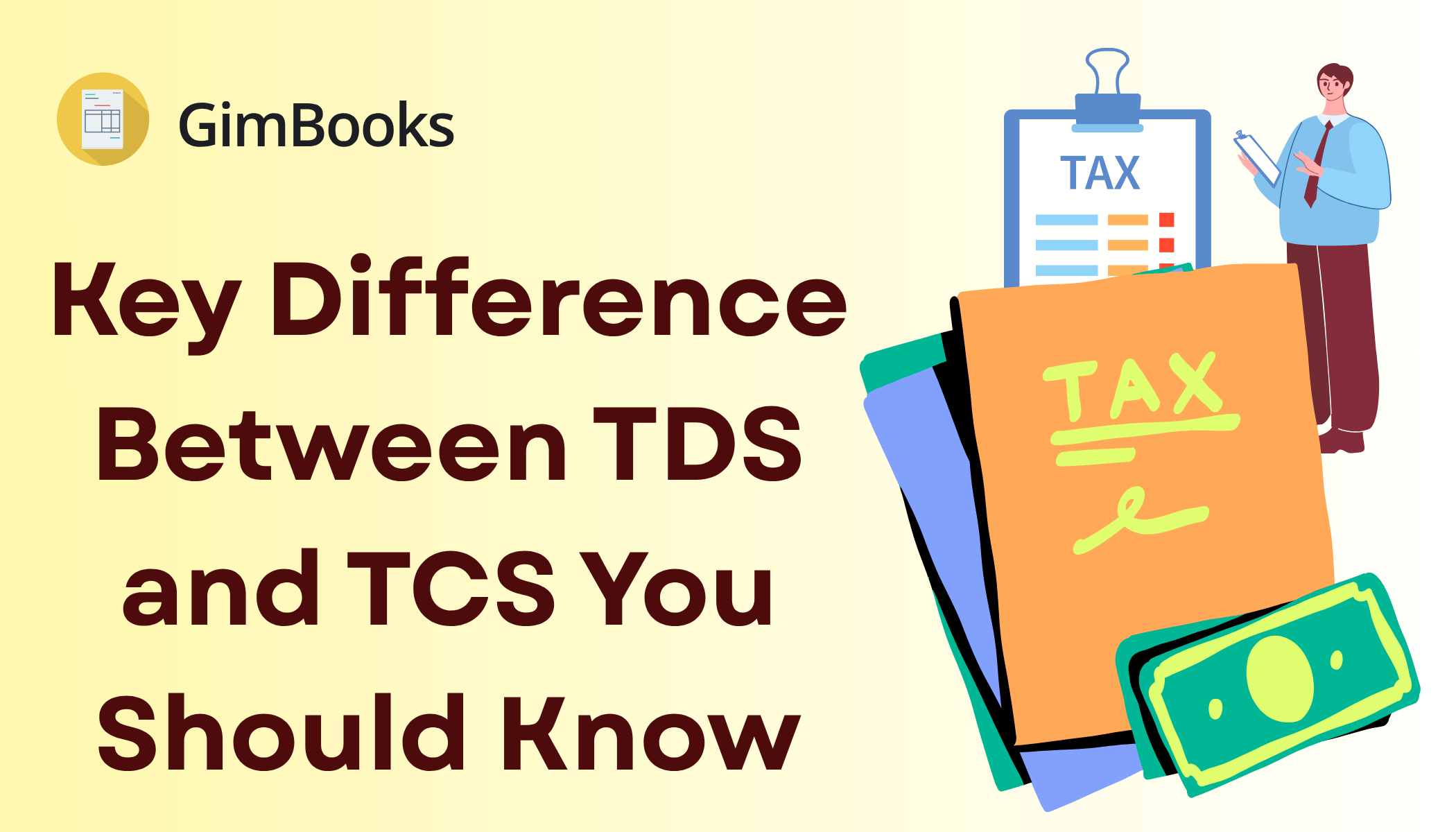Key Difference Between TDS and TCS You Should Know

The difference between TDS and TCS is something every small and micro-sized business in India should understand. These two terms are often mentioned in tax and accounting conversations, especially since the launch of GST.
However, many business owners are still confused about what they really mean, how they apply, and how to handle them correctly. This guide will explain everything in simple terms.
With the right knowledge, handling TDS and TCS becomes easier, and that’s where tools like GimBooks come in.
GimBooks is a cloud-based and mobile-first bookkeeping and business management platform designed especially for small and micro-sized businesses like yours.
What is TDS?
TDS full form: Tax Deducted at Source
TDS means the payer deducts a certain percentage of tax before making a payment to the receiver. This tax is then deposited to the government on behalf of the receiver. It helps the government collect tax in advance.
Example: If you pay Rs. Fifty thousand to a contractor, and the TDS rate is 10%; you will deduct Rs. 5,000 as tax and pay Rs. 45,000 to the contractor. The deducted Rs. 5,000 goes to the government.
Common Payments That Attract TDS:
- Salaries
- Rent
- Contractor payments
- Professional fees
- Commission
TDS is governed by the Income Tax Act 1961, and different payments have different TDS rates.
What is TCS?
TCS full form: Tax Collected at Source
TCS means the seller collects tax from the buyer while selling certain goods or providing services. This tax is then paid to the government by the seller.
Example: If you sell scrap worth Rs. 1,00,000 and the TCS rate is 1%, you will collect Rs. 1,000 extra from the buyer and deposit it to the government.
Common Goods and Services That Attract TCS:
- Sale of scrap
- Sale of minerals
- Sale of timber
- Sale of alcohol
TCS is also regulated by the Income Tax Act 1961 and is mainly used for transactions involving specific goods or services.
TDS vs TCS: Major Differences Explained
Let’s look at the TDS and TCS differences in a simple table format:
TDS and TCS Under GST
What are TDS and TCS in GST? Let’s simplify that too.
TDS under GST
- TDS applies when a government department or notified company makes a payment to a supplier for taxable goods or services.
- The rate is 2% (1% CGST + 1% SGST or 2% IGST).
- This amount is deducted from the payment and deposited to the government.
TCS under GST
- TCS applies to e-commerce operators like Amazon, Flipkart, etc.
- They collect tax at 1% while making payments to sellers registered on their platforms.
- It is done to track online transactions and ensure GST compliance.
Why Is It Important to Understand TDS and TCS?
For small and micro-sized businesses, understanding tds tcs is essential to:
- Stay compliant with Indian tax laws.
- Avoid penalties and late fees.
- Manage cash flow properly.
- File accurate tax returns.
- Build trust with clients and vendors.
Many businesses face trouble just because they don’t know when to deduct or collect tax or how to file it properly.
Trending - TDS Rate Chart Changes 2025
How to Handle TDS and TCS Easily with GimBooks
Tracking, collecting, deducting, and filing TDS and TCS can be hard. But with GimBooks, you get a user-friendly and mobile-first tool that makes the job easy.
Benefits of Using GimBooks
- GST-compliant invoicing: Automatically apply TDS and TCS on invoices.
- Smart reminders: Get alerts for due dates and filings.
- Easy reports: Generate reports like Form 26Q or 27EQ.
- Secure cloud access: Access your data anytime, anywhere.
- Designed for small businesses: No need to hire a full-time accountant!
Whether you sell goods online, run a store, or offer services, GimBooks helps you stay on top of your business finances.
Common Mistakes to Avoid When Handling TDS and TCS
- Not deducting or collecting when required: This can lead to penalties.
- Missing due dates: Late filing results in interest charges.
- Wrong PAN or GST details: These can lead to rejections and legal issues.
- Incorrect rates: Each section has its rate, so be careful.
- No proper records: Always keep receipts, payment slips, and challans.
Avoid these mistakes by using a reliable tool like GimBooks.
Also read - Difference Between Debit Note and Credit Note in GST
Summing Up
Understanding the difference between TDS and TCS is not just about tax compliance; it’s also about running a smooth and trustworthy business. Small and micro-sized business owners often get confused, but the rules are quite simple once you break them down.
And with a smart solution like GimBooks, managing TDS and TCS is easier than ever. Whether it's tracking tax, creating invoices, or filing returns, GimBooks gives you the tools to stay ahead.
Ready to simplify your tax tasks? Visit GimBooks today and take control of your business accounting!
To know more, explore GimBook's informative blogs!
Suggested read - Difference Between Cash Flow and Fund Flow
Frequently Asked Questions (FAQs)
1. Is TDS refundable?
Yes. If excess TDS is deducted, you can claim a refund while filing your income tax return.
2. Can a seller deduct TDS?
No. TDS is always deducted by the buyer/payer.
3. Who should collect TCS?
Only those who sell specific goods are listed under Section 206C.
4. Is TDS or TCS applicable to freelancers?
Yes. If a freelancer earns above a certain limit, the client must deduct TDS.
5. What is the TDS and TCS return filing date?
Generally, TDS/TCS must be deposited by the 7th of the next month, and quarterly returns must be filed.
